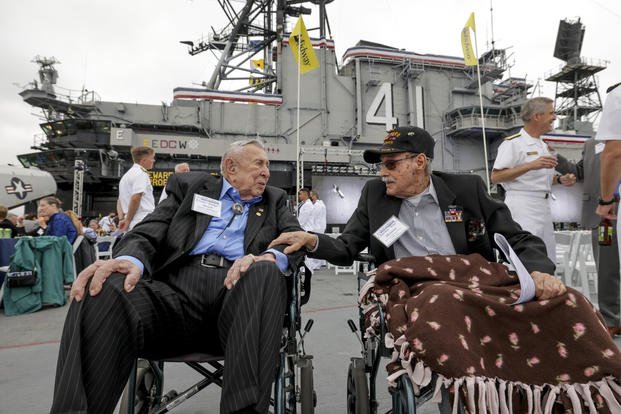

Eighty years ago this weekend, in the Pacific Ocean 3,500 miles off San Diego, a military miracle unfolded.
The U.S. Navy ambushed the Japanese fleet at the Battle of Midway and altered the course of World War II.
Saturday night, aboard the USS Midway Museum in San Diego — a retired aircraft carrier named after the battle — the Navy commemorated the anniversary with an invitation-only ceremony that carried an undertone of sadness.
There aren’t many veterans still alive who were there back then.
Only three were on the guest list: Ervin Wendt, Charles Monroe and Jack Holder, although Holder had to bow out at the last minute. All three men were attached to airplane squadrons during the battle. Each is pushing 100 years old or is past it.
Two made it to the event to hear Vice Adm. Kenneth Whitesell, commander of Naval air forces, talk about the legacy of the battle and tie it to another anniversary: the centennial of the commissioning of the first U.S. aircraft carrier, the Langley.
Midway has long been celebrated as one of the Navy’s greatest victories, a combination of daring and combat skill, much of it improvised. Retired Navy Adm. John Richardson once told a San Diego audience that the full story of the battle “trends toward the miraculous.”
The four-day engagement has been the subject of multiple books, movies, museum exhibits and scholarly conferences that examine every facet of the battle’s planning, execution and aftermath.
“Eighty years ago, the U.S. Navy entered into what would become the pivotal battle in the Pacific during World War II,” Whitesell said during the evening ceremony. “Not only did the U.S. Navy win that battle in Midway atoll, but it established its naval dominance. When we talk about the Midway or read about it in the history books, we often use terms like combat superiority, strategic excellence, but there’s another concept we don’t mention as much, which I believe was just as imperative at Midway. And that is our people and the faith we had in our people during that time.”
Wendt, 106, likes to remind people that some things at play back then can’t easily be analyzed.
“It was a lot of good luck, too,” he told Midway Currents, a museum publication, in an interview last summer.
The battle started June 4, 1942, six months after the devastating attack on Pearl Harbor that pushed the U.S. into World War II.
Japan had followed up with a string of conquests in the Pacific, and Adm. Isoroku Yamamoto readied an invasion of Midway, a strategic U.S.-held atoll about 1,300 miles northwest of Oahu.
What Yamamoto didn’t know is that U.S. analysts had deciphered enough of the Japanese communications codes to recognize Midway as a coming target. Adm. Chester Nimitz organized an ambush.
Despite the element of surprise, Wendt wasn’t confident about the U.S. chances. “We were outmatched in the air with their Zeros (fighter planes) against our TBDs (torpedo bombers),” he told Midway Currents. “We were outnumbered all the way across the board in ships and planes.”
Wendt and Monroe, 99, were both attached to a torpedo bomber squadron, VT-8. Early in the battle, its planes were decimated in aerial combat. But those skirmishes unsettled the Japanese — where was the next wave coming from? — and left them vulnerable to subsequent attacks.
“We caught the Japanese at the right time when they were taking torpedoes off their planes on the flight deck and replacing them with bombs,” Monroe remembered, also in the Midway Currents interview. “Although we lost our squadron first, we later caught them flat-footed.”
By the time the fighting was over, Japan had lost more than 3,000 men, four aircraft carriers, one heavy cruiser and 250 planes. The U.S. paid a price, too — 307 men, one carrier, one destroyer, 150 planes — but the tide was turned. U.S. forces were able to go on the offensive in the Pacific.
According to biographies provided by the Navy, all three Midway veterans saw additional combat at places like Guadalcanal, Tarawa and the Solomon Islands. Holder, 100, also served in the European theater during the war.
Fast forward to present day, Whitesell reminded his audience that the threats the world faces today are not so different from those eight decades ago.
“Today we find ourselves in a starkly similar environment to what we experienced 80 years ago as our country supports the Ukrainian people against the unprovoked attack by Russia, while simultaneously facing a very real possibility of conflict in the Pacific,” he said.
“We still carry the fighting spirit of those heroes who fought at Midway.”
Karl Zingheim, the USS Midway Museum’s historian, said it’s important to preserve the stories of those who participated in key battles, especially Midway.
“A main lesson of Midway is that individuals matter,” he said in an interview Friday afternoon. “It’s one of the few examples in the history of mechanized, industrial warfare where what someone does or fails to do can turn the course of the battle. You see that over and over at Midway. It’s a legacy worth remembering.”
Staff writer Lori Weisberg contributed to this report.
©2022 The San Diego Union-Tribune. Visit sandiegouniontribune.com. Distributed by Tribune Content Agency, LLC.
© Copyright 2022 The San Diego Union-Tribune. All rights reserved. This material may not be published, broadcast, rewritten or redistributed.
